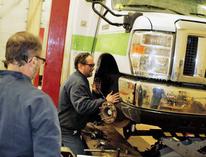
After adapting to the pandemic’s challenges, Prairie Five and other transportation providers—no matter their service areas—face a significant lingering challenge: A market that makes it difficult and expensive to find new vehicles and maintain existing ones.
Using buses, vans, and volunteer driver services, Prairie Five RIDES provides transportation access throughout the state to residents of Big Stone, Chippewa, Lac qui Parle, Swift, and Yellow Medicine counties.
In Ramsey County, Newtrax—in addition to providing transportation for founding organizations Merrick and PAI— helps fill transportation gaps in the community for people with disabilities, seniors, municipal organizations, and local companies with event-based transportation needs. Newtrax operates the Transit Coordination Assistance Project (TCAP) for Ramsey County and the neighboring counties of Washington, Hennepin, Anoka, Dakota.
“Typically, Newtrax orders six buses a year through the Minnesota state contract, and we have not received any buses since spring 2020,” said Mike Greenbaum, Newtrax executive director and TCAP mobility manager. Newtrax normally would have replaced 18 buses in its 55-bus fleet with new ones. With shortages, that has not happened.
“We at Newtrax are extremely fortunate that we have our own maintenance garage and annex that allow us to maintain our own vehicles and be able to quickly respond to repairs,” Greenbaum said.
Still, the situation can impact passenger ride comfort and result in increased maintenance costs. Coupled with worker shortages, these vehicle issues also affect Newtrax’s ability to expand service.
Similarily, Prairie Five RIDES is waiting for 11 new buses and has kept vehicles out of service for varying lengths of time while waiting for replacement parts, said Paul Coyour, RIDES program director. Coyour also has noticed the rise in repair costs and longer wait times for parts.
“We are short drivers, and for that reason we have some vehicles sitting. So if a vehicle goes down for repairs, we have a vehicle that can be used until the damaged one is repaired,” Coyour said.
Prairie Five also keeps a careful eye on vehicle maintenance.
“We have had our maintenance team check out all the vehicles constantly and make sure they get in for their scheduled maintenance checks,” Coyour said. “This has worked well for us, as we can catch some issues in the early stages before they become a major issue and cause a vehicle to be placed out of service.”

During COVID, Newtrax added an extra mechanic and increased hours for existing mechanics to help maintain the fleet, said Scott Olson, community transportation coordinator for Newtrax and TCAP mobility manager. The organization also was able to purchase a small number of used buses to replace older buses.
“We try to be as proactive as we possibly can in looking at different ways to meet our equipment needs,” Greenbaum said.
Based on conversations with peers from other agencies, the Prairie Five RIDES program has been fortunate, Coyour said. “I have talked to other managers who have had vehicles out of service for two to three months waiting for parts and have no back-up vehicles. Because of this, they have had to cut some services temporarily.”
Newtrax has received requests for transportation assistance from senior communities that have a bus but can’t find parts or afford new buses, Olson said. “We do the best we can to fill those gaps.”
Those efforts include collaborating with senior communities on potential solutions. Newtrax, for example, runs a circular loop route among senior buildings, which gives seniors access to shopping. Newtrax is also helping school districts that are unable to provide transportation for students to after-school activities.
There is some reason for optimism, with indications that orders for new buses may be filled within a year. New buses still come with sticker shock, though—their costs are running about 50 percent higher than in 2020, Greenbaum said.
As new vehicles remain scarce and costs for them rise, the search will continue for solutions, Olson said.
“To those that are looking for transportation needs, such as a senior community, reach out to service providers to see how you could combine efforts to get some service. And to those who are in our provider-type situation, also reach out to partner in as many ways as possible until we can get through this crisis,” he said.

